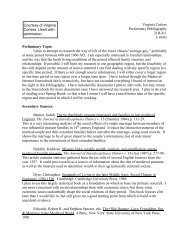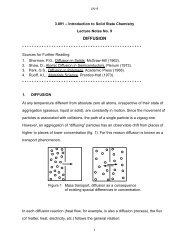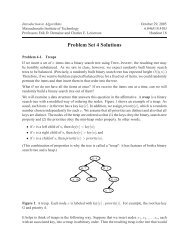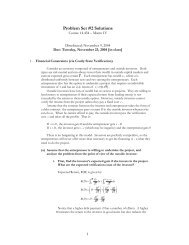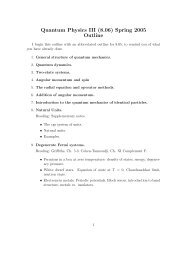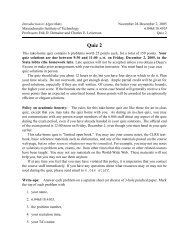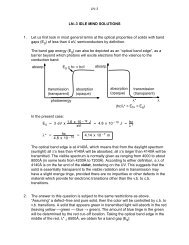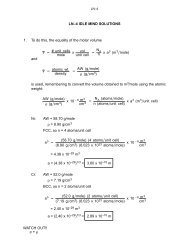18.03 Class 21, April 3 Fun with Fourier series [1] If f(t) is any decent ...
18.03 Class 21, April 3 Fun with Fourier series [1] If f(t) is any decent ...
18.03 Class 21, April 3 Fun with Fourier series [1] If f(t) is any decent ...
You also want an ePaper? Increase the reach of your titles
YUMPU automatically turns print PDFs into web optimized ePapers that Google loves.
<strong>18.03</strong> <strong>Class</strong> <strong>21</strong>, <strong>April</strong> 3<strong>Fun</strong> <strong>with</strong> <strong>Fourier</strong> <strong>series</strong>[1] <strong>If</strong> f(t) <strong>is</strong> <strong>any</strong> <strong>decent</strong> periodic of period 2pi, it has exactly one expression asf(t) = (a0/2) + a1 cos(t) + a2 cos(2t) + ... (*)+ b1 sin(t) + b2 sin(2t) + ...To be prec<strong>is</strong>e, there <strong>is</strong> a single l<strong>is</strong>t of coefficients such thatth<strong>is</strong> <strong>is</strong> true for every value of t = a for which f(t) <strong>is</strong> continuousat a.The coefficients can be computed by the integral formulasa_n = (1/pi) integral_{-pi}^pi f(t) cos(nt) dtb_n = (1/pi) integral_{-pi}^pi f(t) sin(nt) dtbut one can often d<strong>is</strong>cover them <strong>with</strong>out evaluating these integrals.[2] Example: the "standard squarewave" sq(t) = 1 for 0 < t < pi,-1 for -pi < 0 < 0has <strong>Fourier</strong> <strong>series</strong>sq(t) = (4/pi) sum_{n odd} (sin(nt))/nas we saw by calculating the integrals. Let's review that:Any odd function has a sine <strong>series</strong> -- a_n = 0 for all n -and the b_n's can be computed using the simpler integralb_n = (2/pi) int_0^pi f(t) sin(nt) dtIn that range sq(t) = 1 , so we must computeint_0^pi sin(nt) dt = - (1/n) cos(nt) |_0^piNow the graph of cos(t) shows that= - (1/n) [ cos(n pi) - 1 ]n | cos(n pi) | 1 - cos(n pi)-----------------------------------------0 | 1 | 01 | -1 | 22 | 1 | 0... ... ...so b_n = (4/n pi) if n <strong>is</strong> odd,= 0 if n <strong>is</strong> even.sq(t) = (4/pi) [ sin(t) + (1/3) sin(3t) + (1/5) sin(5t) + ... ]= (4/pi) sum_{n odd} (1/n) sin(nt)
pi |---/ t = (pi/L)x| /|| / ||/ |-------------- x| Lso we have g(x) = f(t)= (4/pi) (sin(t) + (1/3) sin(3t) + ... ))= (4/pi) (sin(pi x / L) + (1/3) sin(3 pi x / L) + ...Then general appearance of the <strong>Fourier</strong> <strong>series</strong> for a function of period2L <strong>is</strong>g(x) = a0/2 + a1 cos(pi x / L) + a2 cos(2 pi x / L) + ...+ b2 sin(pi x / L) + b2 sin(2 pi x / L) + ...The integral formulas for an and bn can of course be translatedinto the variable x:an = (1/L) integral_{-L}^L g(x) cos(pi n x / L) dxbn = (1/L) integral_{-L}^L g(x) sin(pi n x / L) dx[5] Gibbs effect. What happens at points where f(t) <strong>is</strong>d<strong>is</strong>continuous?Definition: A function f(t) <strong>is</strong> "piecew<strong>is</strong>e continuous" if it <strong>is</strong>continuous except at some sequence of points $c_n$, and for each $n$both one-sided limits ex<strong>is</strong>t at $c_n$. (<strong>If</strong> the two limits are equal thenthe function <strong>is</strong> continuous there.)Notation: lim_{t-->c from above} f(x) = f(c+)lim_{t-->c from below} f(x) = f(c-)To find out, I got Matlab to sum the first 10 nonzero terms of the<strong>Fourier</strong> <strong>series</strong> for (pi/4) sq(t) ; that <strong>is</strong>,sin(t) + (1/3) sin(3t) + ... + (1/19) sin(19t)One thing's clear: the value of the <strong>Fourier</strong> <strong>series</strong> at 0 <strong>is</strong> 0 .Th<strong>is</strong> <strong>is</strong> a general fact:<strong>If</strong> f(t) <strong>is</strong>n't continuous at t = a , then the sum at t = aconverges to(f(a+) + f(a-))/2 .More surpr<strong>is</strong>ing <strong>is</strong> that the <strong>Fourier</strong> approximation has v<strong>is</strong>ibleoscillation about the constant values of sq(t),
and seems to step back before it launches itself across the gap at thed<strong>is</strong>continuities of sq(t) . Maybe we just need more terms. Matlabcomputed the first 100 nonzero terms,sin(t) + (1/3) sin(3t) + ... + (1/199) sin(199t)The graph <strong>is</strong> even flatter, but still shows a sharp overshoot near thed<strong>is</strong>continuities in sq(t) .The experimental physic<strong>is</strong>t A. A. Michaelson computed the <strong>Fourier</strong> <strong>series</strong>to great accuracy for some d<strong>is</strong>continuous functions and d<strong>is</strong>covered th<strong>is</strong>overshoot in 1898. (I believe that he built a mechanical device for thepurpose.) He communicated h<strong>is</strong> puzzlement to mathematicians, and Gibbstook up the challenge and publ<strong>is</strong>hed an explanation in 1899. What hefound <strong>is</strong> now called the "Gibbs effect":<strong>If</strong> f(t) <strong>is</strong> d<strong>is</strong>continuous at t = a then for <strong>any</strong> n there <strong>is</strong> t = bnear t = a such that the sum of the first n <strong>Fourier</strong> terms at t = bdiffers from f(b) by at least 8% of the gap.The actual limiting overshoot <strong>is</strong> given by (0.0894898722360836...) timesthe gap. The explanation of th<strong>is</strong> strange irrational constant can befound in the Supplementary Notes.The Gibbs effect was first d<strong>is</strong>covered theoetically by a Brit<strong>is</strong>hmathematician named Wilbraham in 1848, but h<strong>is</strong> work was forgotten by everyone tillafter Gibb's publication.


![18.03 Class 21, April 3 Fun with Fourier series [1] If f(t) is any decent ...](https://img.yumpu.com/51148985/1/500x640/1803-class-21-april-3-fun-with-fourier-series-1-if-ft-is-any-decent-.jpg)

